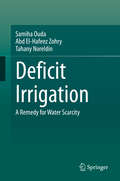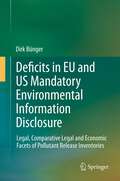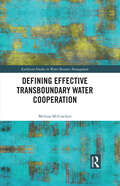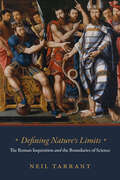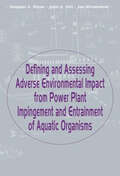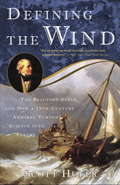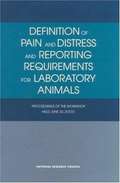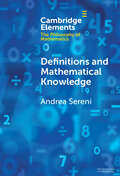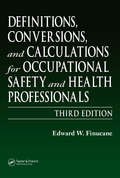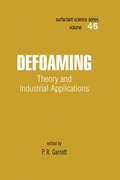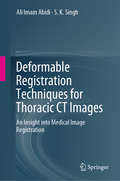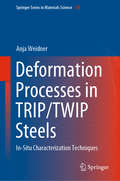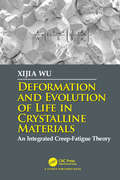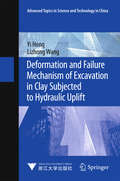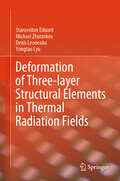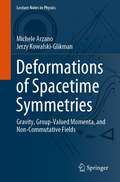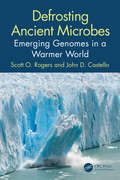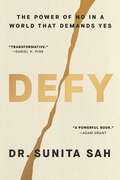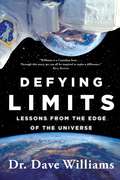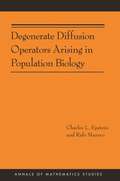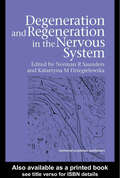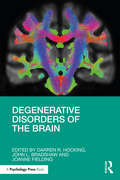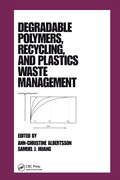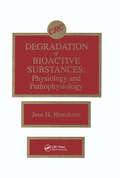- Table View
- List View
Deficit Irrigation: A Remedy for Water Scarcity
by Samiha Ouda Tahany Noreldin Abd El-Hafeez ZohryThis book focuses on proving that deficit irrigation could play an important role in increasing food production in times of water scarcity. Although the application of deficit irrigation can involve loss in crop productivity, it still secures water to be use in cultivating more lands and producing more food. The following questions are discussed and the authors offer solutions to these problems:Will the production, on a national level, resulting from these new added areas compensate yield losses attained by application of deficit irrigation?Is it possible to use deficit irrigation practice to reduce the applied irrigation water to certain crops that have a surplus in their production, and direct this saved water to cultivate new areas with crops have low self-sufficiency ratios? Under climate change in 2030, would deficit irrigation practice have the same role it plays under the current conditions? This book will appeal to students and researchers involved with water scarcity and food security.
Deficits in EU and US Mandatory Environmental Information Disclosure
by Dirk BüngerIt is the publicity about the Pollutant Release Inventory's data which creates an incentive for firms to achieve emission reductions. Accordingly, public access to environmental information constitutes a core characteristic of the aforementioned inventory. Here, in essence, two facets arise. First, with regard to the collection, it is disputed whether such information, which may comprise confidential commercial and industrial information in the EU as well as trade secrets in the US, can be protected under fundamental and constitutional property rights respectively. Second, in the context of dissemination and utilisation, it is arguable whether the information indeed impacts polluters and produces an outcome that secures a certain level of environmental protection. The author responds to the first issue by taking the EU and US jurisdictions into account and strives to analyse how this novel form of Internet disclosure liberates market mechanisms in the quest for effective and efficient emission reductions.
Defining Effective Transboundary Water Cooperation (Earthscan Studies in Water Resource Management)
by Melissa McCrackenThis book establishes a framework for defining transboundary water cooperation and a methodology for evaluating its effectiveness, which will contribute to more effective and therefore successful cooperation processes. With the increasing focus on transboundary cooperation as a part of the Sustainable Development Goal Framework, there is global recognition of transboundary water cooperation as a tool for improved governance and management of transboundary surface and groundwaters. However, there is not an agreed upon definition of transboundary water cooperation in the literature or in practice. This book develops the Four Frames of Transboundary Water Cooperation, which is a neutral modular framework for developing context-specific explanatory definitions of transboundary water cooperation in basins and aquifers. The Four Frames of Cooperation are legal, institutional, relational, and outcome. However, we need to move beyond defining cooperation to understand better measures of the quality and effectiveness of cooperative processes. The Weighted Model of Effective Cooperation presents a first step in qualitatively evaluating the effectiveness of transboundary water cooperation. This model defines effective transboundary water cooperation and operationalizes a method to evaluate the effectiveness of cooperative processes over internationally shared waters. Effective cooperation emphasizes the relational and outcome frames of cooperation while working towards equitability and sustainability. Together, the Four Frames of Cooperation and the Weighted Model of Effective Cooperation will improve the understanding of cooperation and encourage a detailed evaluation of the quality, success, and effectiveness of cooperative processes. This book will be of great interest to students and scholars of water resource management, water governance, and environmental politics. It will also appeal to policymakers and professionals working in the fields of water conflict, water diplomacy, and international cooperation.
Defining Nature's Limits: The Roman Inquisition and the Boundaries of Science
by Neil TarrantA look at the history of censorship, science, and magic from the Middle Ages to the post-Reformation era. Neil Tarrant challenges conventional thinking by looking at the longer history of censorship, considering a five-hundred-year continuity of goals and methods stretching from the late eleventh century to well into the sixteenth. Unlike earlier studies, Defining Nature’s Limits engages the history of both learned and popular magic. Tarrant explains how the church developed a program that sought to codify what was proper belief through confession, inquisition, and punishment and prosecuted what they considered superstition or heresy that stretched beyond the boundaries of religion. These efforts were continued by the Roman Inquisition, established in 1542. Although it was designed primarily to combat Protestantism, from the outset the new institution investigated both practitioners of “illicit” magic and inquiries into natural philosophy, delegitimizing certain practices and thus shaping the development of early modern science. Describing the dynamics of censorship that continued well into the post-Reformation era, Defining Nature's Limits is revisionist history that will interest scholars of the history science, the history of magic, and the history of the church alike.
Defining Nature's Limits: The Roman Inquisition and the Boundaries of Science
by Neil TarrantA look at the history of censorship, science, and magic from the Middle Ages to the post-Reformation era. Neil Tarrant challenges conventional thinking by looking at the longer history of censorship, considering a five-hundred-year continuity of goals and methods stretching from the late eleventh century to well into the sixteenth. Unlike earlier studies, Defining Nature’s Limits engages the history of both learned and popular magic. Tarrant explains how the church developed a program that sought to codify what was proper belief through confession, inquisition, and punishment and prosecuted what they considered superstition or heresy that stretched beyond the boundaries of religion. These efforts were continued by the Roman Inquisition, established in 1542. Although it was designed primarily to combat Protestantism, from the outset the new institution investigated both practitioners of “illicit” magic and inquiries into natural philosophy, delegitimizing certain practices and thus shaping the development of early modern science. Describing the dynamics of censorship that continued well into the post-Reformation era, Defining Nature's Limits is revisionist history that will interest scholars of the history science, the history of magic, and the history of the church alike.
Defining and Assessing Adverse Environmental Impact from Power Plant Impingement and Entrainment of Aquatic Organisms: Symposium in Conjunction with the Annual Meeting of the American Fisheries Society, 2001, in Phoenix, Arizona, USA
by Joe Wisniewski Douglas A. Dixon John A. VeilThe U.S. Clean Water Act calls for the minimization of "adverse environmental impact" at cooling water intake structures. To facilitate an exchange of information among all stakeholders in the issue, the Electric Power Research Institute organised a national symposium in 2001 to discuss the meaning of adverse environmental impact and methods
Defining the Wind: The Beaufort Scale, and How a 19th-century Admiral Turned Science into Poetry
by Scott HulerA remarkable journey over land and sea into a fascinating world of explorers, mariners, scientists, and writers. Huler was so taken with the Beaufort Wind Scale that he went in search of Adm. Francis Beaufort himself: hydrographer to the British Admiralty, man of science, and author -- Huler assumed -- of the Beaufort Wind Scale. But the scale that carries Beaufort's name has a long and complex evolution, and to properly understand it means reaching farther back in history, into the lives and works of figures from Daniel Defoe and Charles Darwin to Captains Bligh and Cook. All around the world in the mid-18th and 19th century, modern science was being invented every day. A wonderfully readable story that is ultimately about how we observe the forces of nature and the world around us.
Definition Of Pain And Distress And Reporting Requirements For Laboratory Animals: Proceedings Of The Workshop Held June 22, 2000
by Committee on Regulatory Issues in Animal Care UseA report on the Definition Of Pain And Distress And Reporting Requirements For Laboratory Animals
Definitions and Mathematical Knowledge (Elements in the Philosophy of Mathematics)
by Andrea SereniThis Element discusses the philosophical roles of definitions in the attainment of mathematical knowledge. It first focuses on the role of definitions in foundational programs, and then examines their major varieties, both as regards their origins, their potential epistemic roles, and their formal constraints. It examines explicit definitions, implicit definitions, and implicit definitions of primitive terms, these latter being further divided into axiomatic and abstractive. After discussing elucidations and explications, various ways in which definitions can yield mathematical knowledge are surveyed.
Definitions, Conversions, and Calculations for Occupational Safety and Health Professionals
by Edward W. FinucaneStanding firmly on the foundation built by the previous two editions, each a bestseller in its own right, Definitions, Conversions, and Calculations for Occupational Safety and Health Professionals, Third Edition is bound to repeat this success. A multipurpose reference suitable for professionals throughout the field, the book contains virtually ev
Defoaming: Theory and Industrial Applications (Surfactant Science #45)
by P R. GarrettReviews all known antifoam mechanisms, and discusses the appropriate practical approaches for solving foam control problems in a variety of industrial contexts. These range from crude oil production to detergent formulation.
Deformable Registration Techniques for Thoracic CT Images: An Insight into Medical Image Registration
by Ali Imam Abidi S.K. SinghThis book focuses on novel approaches for thoracic computed tomography (CT) image registration and determination of respiratory motion models in a range of patient scenarios. It discusses the use of image registration processes to remove the inconsistencies between medical images acquired using different devices. In the context of comparative research and medical analysis, these methods are of immense value in image registration procedures, not just for thoracic CT images, but for all types of medical images in multiple modalities, and also in establishing a mean respiration motion model. Combined with advanced techniques, the methods proposed have the potential to advance the field of computer vision and help improve existing methods. The book is a valuable resource for those in the scientific community involved in modeling respiratory motion for a large number of people.
Deformation Processes in TRIP/TWIP Steels: In-Situ Characterization Techniques (Springer Series in Materials Science #295)
by Anja WeidnerThis book demonstrates the potential of novel in-situ experiments, performed on microscopic and macroscopic length scales, for investigating localized deformation processes in metallic materials, particularly their kinetics and the associated evolution of local strain fields. It features a broad methodological portfolio, spanning optical and electron microscopy, digital image correlation, infrared theromgraphy and acoustic emission testing, and particularly focuses on identifying the localized microscopic deformation processes in high-strength/high-ductility CrMnNi TRIP/TWIP (TRansformation Induced Plasticity/TWinning Induced Plasticity) steels. Presenting state-of-the art methodology applied to topical and pertinent problems in materials engineering, this book is a valuable resource for researchers and graduate students working in the field of plasticity and deformation of structural materials.
Deformation and Evolution of Life in Crystalline Materials: An Integrated Creep-Fatigue Theory
by Xijia WuThis book walks you through the fundamental deformation and damage mechanisms. It lends the reader the key to open the doors into the maze of deformation/fracture phenomena under various loading conditions. Furthermore it provides the solution method to material engineering design and analysis problems, for those working in the aerospace, automotive or energy industries. The book introduces the integrated creep-fatigue theory (ICFT) that considers holistic damage evolution from surface/subsurface crack nucleation to propagation in coalescence with internally-distributed damage/discontinuities.
Deformation and Failure Mechanism of Excavation in Clay Subjected to Hydraulic Uplift
by Yi Hong Lizhong WangThis book presents the latest experimental and numerical analysis work in the field of ground deformation and base instability of deep excavations in soft clay subjected to hydraulic uplift. The authors' latest research findings, based on dimensional analyses, well-instrumented full-scale field tests, systematic coupled-consolidation finite element analyses and centrifuge tests are reported. This book shows how to systematically approach a complex geotechnical problem, from identifying existing problems, reviewing literature, to dimensional and numerical analyses, validation through full-scale testing and centrifuge model testing. The methodologies are also introduced as major tools adopted in geotechnical research.
Deformation of Three-layer Structural Elements in Thermal Radiation Fields
by Yongtao Lyu Michael Zhuravkov Starovoitov Eduard Denis LeonenkoThis book methodically details the formulations and approaches to solve boundary value problems, which are essential for determining the stress–strain states in three-layer rods and plates subjected to both single and quasi-static variable loads in thermal radiation and force fields. It duly considers the complex influences on the physically nonlinear properties of the materials in each layer. The book offers several innovative analytical solutions and a numerical parametric analysis of the stress–strain scenarios in these structures. It describes the deformation of physically nonlinear media in thermoradiational fields within the small elastic-plastic deformations theory framework. The work explores variational problem-solving methods and the elastic solution method. It presents a formula for calculating the temperature within a three-layer assembly, derived by averaging the thermophysical properties of the materials across the layers' thickness. Additionally, the book includes an analysis of the attenuation of neutron flux as it passes through a three-layer element.
Deformations of Spacetime Symmetries: Gravity, Group-Valued Momenta, and Non-Commutative Fields (Lecture Notes in Physics #986)
by Michele Arzano Jerzy Kowalski-GlikmanThis monograph provides an introduction to deformations of Poincaré symmetries focusing on models with a Lie group momentum space and associated non-commutative space-times. The emphasis is put on the emergence of such structures from quantum gravity, their mathematical features described in terms of Hopf algebras and applications to particle kinematics and field theory. Part I of this work focuses on the link between gravity and deformed symmetries in the case of 2+1 and 3+1 space-time dimensions. Part II is devoted to the description of classical particles with group valued momenta, their phase spaces and kinematics. The last part of these notes provides an introduction to the basic features of classical and quantum field theory on κ-Minkowski space-time, the prototypical example of non-commutative space-time exhibiting deformed Poincaré symmetry. The text, being the first providing a detailed overview of these topics, is primarily intended for researchers and graduate students interested in non-commutative field theories and quantum gravity phenomenology.
Defrosting Ancient Microbes: Emerging Genomes in a Warmer World
by John D. Castello Scott RogersIce is melting around the world and glaciers are disappearing. Water, which has been solid for thousands and even millions of years, is being released into streams, rivers, lakes and oceans. Embedded in this new fluid water, and now being released, are ancient microbes whose effects on today's organisms and ecosystems is unknown and unpredictable. These long sleeping microbes are becoming physiologically active and may accelerate global climate change. This book explores the emergence of these microbes. The implications for terrestrial life and the life that might exist elsewhere in the universe are explored. Key Selling Points: Explores the role of long frozen ancient microbes will have when released due to global warming Describes how ice preserves microbes and microbial genomes for thousands or millions of years Reviews work done on permafrost microbiology Identifies potential health hazards and environmental risks Examines implications for the search for extraterrestrial life.
Defy: The Power of No in a World That Demands Yes
by Dr. Sunita SahWhy is it so hard to speak up, even when we know something&’s wrong?This is the definitive book on defiance, a clear-eyed dissection of the forces that silence us, featuring groundbreaking research and legendary stories alongside everyday examples and strategies for how to unleash the power of a &“True No.&”Many of us comply much more than we realize. How many times have you wanted to object, disagree, or opt out of something but ended up swallowing your words, shaking your head, and just going along? Analyzing cases ranging from corporate corruption and sexual abuse to everyday acquiescence at work, the doctor&’s office, and in our personal lives, award-winning organizational psychologist Dr. Sunita Sah delves deep into why the pressure to comply is a corrosive and often invisible force in our society.With her own revelatory research, she radically transforms our idea of defiance from a misunderstood negative trait into a crucial, positive force for personal and societal change. Taking us through her five stages of defiance, Dr. Sah equips readers with simple tools to make decisions that align with their values. Defy is the essential playbook for how to speak up and act when it matters most.
Defying Limits: Lessons from the Edge of the Universe
by Dave WilliamsAn inspirational, uplifting, and life-affirming memoir about passion, resilience and living life to the fullest, from Dr. Dave Williams, one of Canada’s most accomplished astronauts.I had dreamt about becoming an astronaut from the time I watched Alan Shepard launch on the first American sub-orbital flight on May 5, 1961. Eleven days before my seventh birthday, I committed to a new goal: one day, I would fly in outer space. Dr. Dave has led the sort of life that most people only dream of. He has set records for spacewalking. He has lived undersea for weeks at a time. He has saved lives as an emergency doctor, launched into the stratosphere twice, and performed surgery in zero gravity. But if you ask him how he became so accomplished, he’ll say: “I’m just a curious kid from Saskatchewan.” Curious indeed. Dr. Dave never lost his desire to explore nor his fascination with the world. Whether he was exploring the woods behind his childhood home or floating in space at the end of the Canadarm, Dave tried to see every moment of his life as filled with beauty and meaning. He learned to scuba dive at only twelve years old, became a doctor despite academic struggles as an undergraduate, and overcame stiff odds and fierce competition to join the ranks of the astronauts he had idolized as a child. There were setbacks and challenges along the way—the loss of friends in the Columbia disaster, a cancer diagnosis that nearly prevented him from returning to space—but through it all, Dave never lost sight of his goal. And when he finally had the chance to fly among the stars, he came to realize that although the destination can be spectacular, it’s the journey that truly matters. In Defying Limits, Dave shares the events that have defined his life, showing us that whether we’re gravity-defying astronauts or earth-bound terrestrials, we can all live an infinite, fulfilled life by relishing the value and importance of each moment. The greatest fear that we all face is not the fear of dying, but the fear of never having lived. Each of us is greater than we believe. And, together, we can exceed our limits to soar farther and higher than we ever imagined.
Degenerate Diffusion Operators Arising in Population Biology (Annals of Mathematics Studies #185)
by Charles L. Epstein Rafe MazzeoThis book provides the mathematical foundations for the analysis of a class of degenerate elliptic operators defined on manifolds with corners, which arise in a variety of applications such as population genetics, mathematical finance, and economics. The results discussed in this book prove the uniqueness of the solution to the Martingale problem and therefore the existence of the associated Markov process. Charles Epstein and Rafe Mazzeo use an "integral kernel method" to develop mathematical foundations for the study of such degenerate elliptic operators and the stochastic processes they define. The precise nature of the degeneracies of the principal symbol for these operators leads to solutions of the parabolic and elliptic problems that display novel regularity properties. Dually, the adjoint operator allows for rather dramatic singularities, such as measures supported on high codimensional strata of the boundary. Epstein and Mazzeo establish the uniqueness, existence, and sharp regularity properties for solutions to the homogeneous and inhomogeneous heat equations, as well as a complete analysis of the resolvent operator acting on Hölder spaces. They show that the semigroups defined by these operators have holomorphic extensions to the right half-plane. Epstein and Mazzeo also demonstrate precise asymptotic results for the long-time behavior of solutions to both the forward and backward Kolmogorov equations.
Degeneration and Regeneration in the Nervous System
by N. R. Saunders K. M. DziegielewskaDegeneration and Regeneration in the Nervous System brings together an international team of contributors to produce a series of critical reviews appraising key papers in the field. The pace of research on brain and spinal cord injury quickened considerably in the last ten years and there is much that is new and important that is covered in this bo
Degenerative Disorders of the Brain
by John L. Bradshaw Darren R. Hocking Joanne FieldingCovering a wide range of diverse age-related disorders, Degenerative Disorders of the Brain addresses disabilities that occur or have their roots in the later stages of life. The book brings together an internationally recognised group of contributors to discuss frontostriatal, fronto-cerebellar and other major brain systems and structures which control and direct normal behaviour, and which can fail during the aging process, as well as addressing behavioural, clinical, pathophysiological and technical aspects. Discussing the latest clinical and behavioural findings of disorders which are largely, though not necessarily entirely, age related, including Alzheimer’s disease and other dementias, Parkinson’s disease and related disorders, and Huntington’s disease, the book covers information vital to the understanding, diagnosis, and management of degenerative disorders of the brain. It also considers the role of epigenetics, neural plasticity, and environmental enrichment in neurodegenerative disorders alongside the role of ground-breaking intervention methods, including transcranial magnetic stimulation and deep brain stimulation. Degenerative Disorders of the Brain will be of great interest to, and use for, clinicians, researchers, students, lecturers, and affected individuals and their relatives.
Degradable Polymers, Recycling, and Plastics Waste Management
by AlbertssonBased on the International Workshop on Controlled Life-Cycle of Polymeric Materials held in Stockholm, this work examines degradable polymers and the recycling of plastic materials. It highlights recent results on recycling and waste management, including topics such as renewable resources, degradation, processing and products, and environmental is
Degradation of Bioactive Substances: Physiology and Pathophysiology
by Jens H. HenriksenIntended primarily for researchers working with bioactive substances such as hormones, neurotransmitters, growth factors, and connective tissue makers, this book discusses the principles of degradation in major groups of bioactive materials with respect to physiology, location, and regulation. Peptidases; receptor-mediated endocytosis; organ extraction and clearance; and the degradation of specific proteins, peptides, amines, steroids, and polysaccharoides are featured. Pathophysiology and its role in diagnostics and disease are considered throughout the book, in addition to updates of recent literature and substantial new information on physiology and pathophysiology of degradation of bioactive material. No special mathematical or kinetic background is necessary to read this book because the mathematic and kinetic concepts are facilitated through the presentation of fundamental and more advanced principles. Furthermore, illustrations and tables are provided to facilitate the understanding of the dynamic aspects of degradation processes. Degradation of Bioactive Substances: Physiology and Pathophysiology is the first comprehensive work describing the degradation of bioactive material, including information not found in biochemical textbooks on internal metabolism or pharmacokinetic textbooks on drug metabolism.
